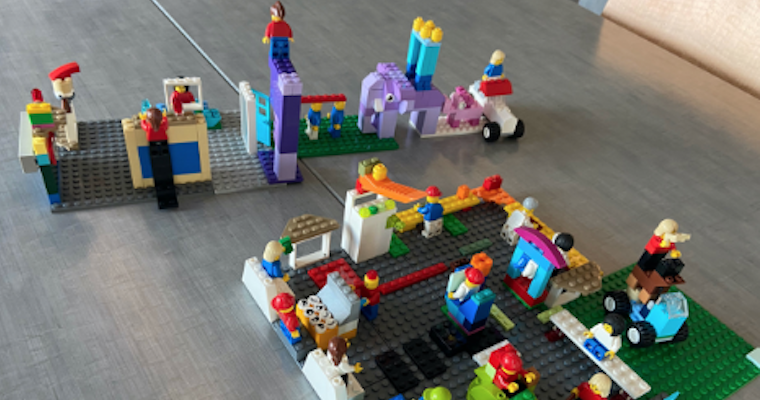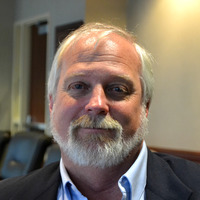Integrate LEGO® Serious Play® for Collective Creativity

This classroom exercise integrates LEGO® Serious Play® (LSP) during the Ideation process. This exercise helps students to learn the concepts of collective creativity and results in 100% participation. It provides students with a deeper insight of using playing to drive creativity. This exercise also demonstrates the value of storytelling as a divergent thinking tool to unlock imagination. It can be adapted for the online classroom (see below.)
Keywords: Ideation, LEGO Serious Play, Collective creativity, Storytelling
Subject Area: Ideation
Student Level: Any level
Type of Course: Creativity and Innovation course or workshop with a module on idea generation.
Time Required: 75 minutes minimum
Recommended Number of Students: In order to facilitate the interactive session effectively, this is recommended for a class size up to 18 students. Students will work in a team of no more than 6 members to give each student enough time to share.
LEARNING OBJECTIVES
Collective creativity is built on “the need to both unleash individual slices of genius and harness them into collective genius” (Hill, et al, 2014). As individuals use creativity to generate new combinations of existing ideas, concepts, fields or items to create something novel and useful (McCrae,1987), collective creativity emphasizes unleashing talents who shape those ideas and options and select new and useful solutions in organizations (Hill, et al, 2014). In the classroom, it is essential for students to understand that everyone has the potential to be creative, and that everyone should contribute to shape and develop a new idea in the innovation development process. The collective innovation process includes two main elements: first, the individual’s divergent thinking to allow individuals generating their own ideas independently; second, the team’s collaboration to converge diverse ideas and options from individuals, even when they may seem mutually exclusive, to create new and better ideas.
However, we are all familiar with the meeting agony endured in classrooms or organizations: a few people talk a lot, many watch their mobile devices, and no one is really listening. Such a situation often happens during Ideation: several participants dominate the conversation and push their ideas, while those with great ideas may keep quiet. The challenge is how we can truly engage everyone to contribute to the collective creativity process, either in the classroom or in real-life.
LSP is an effective tool to address the issue for participants around a table to “lean in, unlock new knowledge, and break habitual thinking” (Kristiansen & Rasmussen, 2014, p15). First, LSP enables participants to physically lean into a conversation in which 100 percent of attendees contribute. Second, using LEGO bricks to build a 3-D model visible to the audience, participants -- even shy and passive ones -- can use their imagination to unlock their full potential. Finally, through the engaged playing, constructing and connecting thoughts, LSP breaks individuals' habitual patterns of thinking, which leads to a surprising solution (Kristiansen & Rasmussen, 2014). This is particularly relevant to divergent and convergent thinking of Ideation: When everyone build his/her individual model, the participants engage in divergent thinking to generate a large quantity of distinct ideas; when the team constructs a shared model together, they conduct convergent thinking to merge the seemingly unrelated ideas into an improved and better idea without leaving anyone out of the process.
The learning objectives for the exercise include:
- Learn Ideation process through the LSP methodology
- Gain a deep insight of collective creativity
- Utilize storytelling as a divergent thinking tool
- Understand the link between play and creativity
MATERIALS AND PROCESS
As a certified LSP facilitator[1], I integrate the LSP method to teach Ideation in an undergraduate course of Creativity and Innovation. Before the exercise, the students have learned about basic Creative-Problem Solving concepts and processes and have used sticky notes as a brainstorming tool for Ideation. By using LSP, I therefore reinforce the learning of Ideation, and further introduce the concepts of collective creativity and particularly the role of playing in creativity. I required students to watch two TED Talks videos:
- How to manage for collective creativity by Linda Hill (before the session)
- Tales of creativity and play by Tim Brown (after the session)
There are LEGO kits specifically designed for LSP workshops. Instead of using the special kits, I provided the classic LEGO bricks for the class and saved money. (Note: I used one set of 1500-piece classic LEGO from Costco with additional mini figures and flags for a group of 6 students; my class of 18 required three of them.)
The basic elements of this exercise are as follows and the images in the appendix illustrates the engaging process:
- I first offer an initial introduction of the background of LSP and explained why and when LSP could be used. LSP was developed by LEGO Company during the 90s as a thinking, communication and problem-solving methodology. It can be used for simple individual exercises, such as establishing self-identity or leadership training. However, it is particularly useful to solve complex and multifaceted problems without clear answers, such as organization strategic plans or crisis resolutions. It helps to grasp the big picture, see connections and explore various options and potential solutions, especially when the participants are diverse in age, profession or organizational status (Kristiansen & Rasmussen, 2014). In short, the applications of LSP can be limitless.
- The first step is to help students become familiar with the concept of building and sharing with LEGO bricks. Each student is directed to build a tower in 5 minutes. Then every student takes turns to describe their towers and explain any meaningful element of their models.
- Then I divide students into groups of five or six students. They are instructed to build a model in 15 minutes to solve a problem. We continued using our previous Ideation topic to “build a model to show the customer experience of a laundromat.” But the topic can be any challenges that we like to Ideate, from new product development or culture changes in organizations, to environmental or societal issues.
- Once everyone finishes building their individual models, each student describes his/her individual model in detail to reflect his/her view of “customer experience” for a laundromat. If it’s a smaller class, we have enough time for everyone to share in front of the entire class, otherwise, the students can share within their groups. This step represents divergent thinking during Ideation. The advantage of LEGO bricks is to bring out the imagination of students within a short period of time. In my class, the students generated a wide range of ideas: from complex ideas for self-generated renewable energy, play areas for childcare, and theme-based interior design; to simple ideas for gourmet coffee and massage chairs. Each brings unique customer experience from different angles.
- Next, each student will use one red square brick to highlight the most important element of his/her model. It is an important step for students to identify the most creative and meaningful component from their individual ideas.
- Then, in 15-20 minutes, the team will construct a shared model together, incorporating everyone’s important element. This represents convergent thinking of Ideation, a collective design that includes everyone’s idea and connects the unrelated ideas into a new and improved idea.
- As the final step of LSP method, the teams share their team models to describe their collective design of a laundromat that provides the best customer experience.
- Finally, we end the session with a discussion on how LSP relates to Ideation concepts, such as divergent/convergent thinking and collective innovation based on Hill’s TED Talk video assigned before the class. We also briefly bring in the element of playing in creativity.
OUTCOMES
The most valuable outcomes of integrating LSP in Ideation is not about the ideas that students generated, although very interesting ideas emerged from the process. Because LEGO is a beloved toy for almost everyone, students are fully immersed in the constructing and sharing/listening process, and then work collectively as a team to build an improved model. It helps students to realize the value of everyone contributing and sharing their ideas, which is essential for collective creativity. In addition, students practice with the storytelling technique to describe the abstract customer experience based on visual 3-D LEGO models. Storytelling is also essential for innovation and entrepreneurship because it can shape how others understand and relate to the idea (Guber, 2007, Mazurkewich, 2018). Last, the students are assigned to watch Tim Brown’s TED Talk video, which further emphasizes the value of playing in our life and organizations, and how intellectual play (or serious play) can unlock our imagination and drives creativity.
After the session, students submitted their weekly individual journals to reflect on their LSP experience relating to the TED Talks by Linda Hill and Tim Brown. Below are quotes from their journals that demonstrate the learning outcomes of this exercise:
Student 1:
“The idea that I liked the most is the way everyone feels comfortable to speak their minds and to help out even if they are shy. I am not a big talker, but I notice while doing the LEGO Serious Play, not only my team were having fun, but I felt comfortable with giving my opinion and sharing what I thought about what we were doing.
The way I can connect what we did in class and what I saw in the video is the fact that playing and creative thinking has a bigger connection than what we think. As we grow up, we stop playing and become less creative. In Brown’s video, Tim compared child's play vs adults play and it is true. I was taking care of my nephew the other day and realized kids can make a toy out of anything, they barely get bored, and their imagination is limitless. When we are kids, there are no rules, no fear of judgment, or caring if we are wrong or not, everything in a kid’s mind is possible.”
Student 2:
“In Tim Brown’s discussion on Tales of creativity and play, he said 'We go through a generative mode, where we are exploring many ideas; then we come back together again and come back looking for a solution.' This quote is related to the LEGO Serious Play because when building Legos individually, no one's design is going to be the same. Everyone is going to explore and go through many different ideas while building that will lead them to an end result known as a solution… The concept we learned about this week was very helpful towards new life experiences. Playing with the Legos with my other classmates was a great way to learn teamwork. It went along with the topic 'Lean Forward, Not Backwards.'"
Student 3:
“Other variables showing why this is important is to get 100% participation from all individuals, so everyone is able to contribute. The issue that most people undergo is actually contributing to the team. What I learned from our LSP task of building a laundromat experience as a team, was that eventually I couldn't be shy anymore and had to stand up in order to contribute, collaborate, and communicate, to get the best result. In the video, Tim Brown mentioned the idea of Role Play and Construction Play, where when things don't work out when physically building a model or idea, you need to adapt to the change and problem solve towards a better and final solution. Building LEGOs in class definitely gave me a better grasp on what creativity and open-mindedness really is.”
In conclusion, integrating LSP in Ideation can truly open students’ minds about collective creativity. I hope whenever they see LEGO bricks in the future, they will be reminded about the interplay of creativity, innovation, and playing.
ADAPT LSP INTO THE VIRTUAL WORD
By the time I completed this article, we had all been facing the new reality from the COVID-19 pandemic and were forced to shift our education to the virtual world. The plan for the fall semester is still undecided for many schools. Now the question is how we can adapt this highly interactive exercise into the virtual teaching and learning environment? We can still instruct students to utilize their own LEGOs at home or, if funding is available, supply them with one LEGO LSP starter kit. Students can still build their individual models to practice divergent thinking through playing and the storytelling technique through virtual conferencing. For group convergent thinking or collective creativity activity, students can utilize a virtual whiteboard to draw a shared model together and learn the innovation tool of “visualization” which is often used in Design Thinking (For more information, please go to Draw How to Make Toast by Tom Wujec).
In times of increasing uncertainty, complexity, and ambiguity around the world, the effort to integrate LSP in teaching and learning is even more important to me. It reminds me to keep on our journey of searching for creative solutions through imagination and playfulness, so we can continue driving innovation in our education, organizations and society.
References
Guber, P. (2007). The four truths of the storyteller. Harvard Business Review, 85(12), 52.
Hill, L. A., Brandeau, G., Truelove, E., & Lineback, K. (2014). Collective genius: The art and practice of leading innovation. Harvard Business Review Press.
Kristiansen, P., & Rasmussen, R. (2014). Building a better business using the Lego serious play method. John Wiley & Sons.
Mazurkewich, K. (2018). Technical experts need to get better at telling stories. Harvard Business Review
McCrae, R. R. (1987). Creativity, divergent thinking, and openness to experience. Journal of personality and social psychology, 52(6), 1258.
[1] Although it is not required to be a certified facilitator to run this particular exercise for class, it is highly recommended to get facilitator training to have a deep understanding of the method and related materials.



